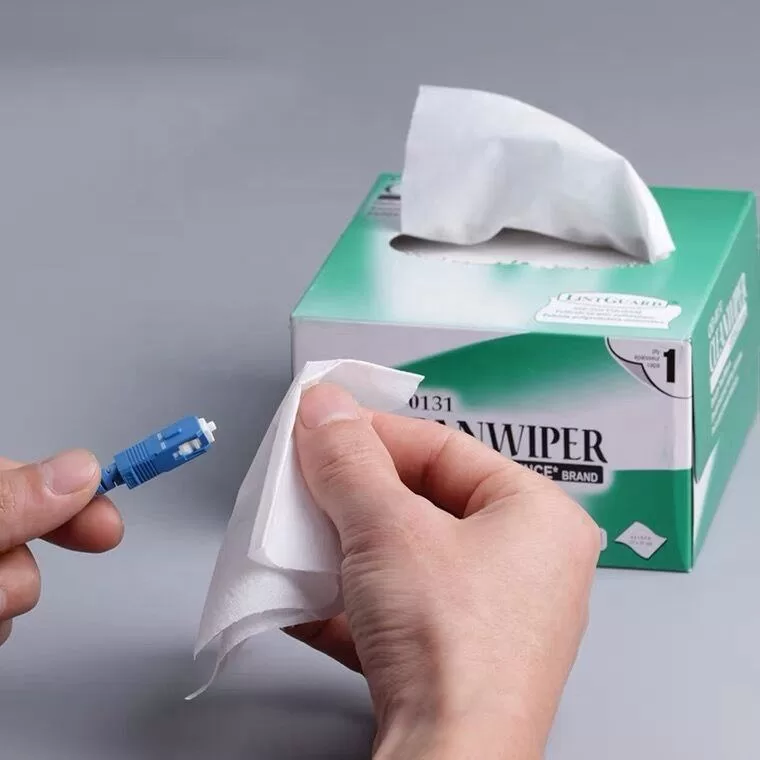Fiber optic networks demand precision. A single particle of dust or a microscopic oil film on a fiber connector can cause signal degradation, high insertion loss, or even permanent damage. That’s why Fiber Cleaning Wipes are an essential tool in every technician’s toolkit. In this article, we’ll walk you through what makes a good fiber cleaning wipe, the different types available, key considerations when buying, and why we recommend Kimtech® Kimwipes as a reliable choice.
What Are Fiber Cleaning Wipes?

Fiber Cleaning Wipes are specialized cleaning materials designed to remove dust, oil, moisture, and other contaminants from optical fiber connectors, splices, and end faces. Unlike ordinary tissues or cloths, these wipes are engineered to be lint-free, chemically pure, and safe to use on sensitive glass surfaces.
Why Proper Fiber Cleaning Is Critical
Fiber optic signals operate at light frequencies, which means even the smallest contamination can:
- Increase insertion loss
- Decrease return loss
- Cause signal reflection y data errors
- Damage connector end faces permanently
Therefore, the cleaning material—especially the wipe—must be highly effective without introducing new contaminants.
Key Features to Look For in Fiber Cleaning Wipes
1. Lint-Free Material
Lint is the enemy of fiber optics. Choose wipes labeled “lint-free” or “low lint”. These prevent particles from remaining on the end face after cleaning.
2. Low Extractables
Extractables are chemical residues that can remain on the fiber surface after wiping. The best wipes are made from materials with minimal chemical content and no binders or glues.
3. Material Type
- Polyester: Excellent strength and very low lint; ideal for precision optics.
- Cellulose: Natural fiber with high absorbency, but higher lint.
- Poly-cellulose blend: Combines the strength of polyester and absorbency of cellulose. Most common for general field use.
4. Solvent Compatibility
Wipes must work well with solvents such as 99% isopropyl alcohol (IPA) or specialized fiber cleaning fluids. A good wipe should absorb and release solvent evenly.
5. Packaging Format
- Pocket-sized packs: Ideal for field technicians.
- Pop-up boxes: Convenient for lab or production environments.
- Pre-saturated wipes: Quick and easy, but shelf life is limited.
6. Cleanroom Compatibility
For cleanroom environments, choose wipes manufactured in ISO Class 5–7 cleanroom conditions to prevent contamination from the manufacturing process.
7. Anti-Static Properties
In dry environments, static buildup can attract particles. Anti-static or ESD-safe wipes reduce this risk.
Dry Wipes vs Pre-Saturated Fiber Cleaning Wipes
| Característica | Dry Wipes | Pre-Saturated Wipes |
|---|---|---|
| Solvent control | Full control | Pre-applied |
| Consistency | Depends on user | Very consistent |
| Shelf life | Long | Short (6–12 months) |
| Convenience | Needs solvent | Ready to use |
| Cost | Más bajo | Más alto |
Recommendation: Dry wipes are versatile and cost-effective when paired with high-purity IPA. Pre-saturated wipes are ideal for fast-paced environments or for less experienced technicians.
Recommended Fiber Cleaning Wipes: Kimtech® Kimwipes

We recommend Kimtech® Kimwipes for fiber cleaning due to their reliable performance, wide availability, and industry reputation. Key benefits include:
- Low lint, minimal particle generation
- Excellent absorbency and wet strength
- Compatible with IPA and fiber-safe solvents
- Economical and available in multiple sizes
Kimwipes are especially effective for cleaning connectors before mating or testing, and they’re gentle enough for delicate optical surfaces.
How to Use Fiber Cleaning Wipes Properly
Step-by-step:
- Inspect the connector using a fiber scope.
- Fold a clean section of the wipe.
- If needed, apply solvent to the wipe (not directly on the connector).
- Wipe in one direction across the end face.
- Use a dry section to remove excess solvent.
- Re-inspect to confirm a clean surface.
Tips:
- Always use a fresh area of the wipe for each connector.
- Do not reuse wipes that have touched a dirty surface.
- Store wipes in a clean, sealed container.
Common Mistakes to Avoid
- Using paper towels or facial tissue: too much lint and chemical residue.
- Spraying solvent directly on connectors.
- Rubbing the same area multiple times.
- Not inspecting the end face after cleaning.
Buying Checklist
Here’s what to check when buying fiber cleaning wipes:
- Lint-free or low-lint material
- Compatible with fiber-safe solvents
- Poly-cellulose or polyester material
- Pocket or pop-up box packaging
- Cleanroom certified (if required)
- Anti-static (for dry environments)
FAQs: Fiber Cleaning Wipes
1. Can I use any tissue to clean fiber connectors?
No. Ordinary tissues release lint and may contain additives that leave residue. Use only lint-free wipes rated for fiber optics.
2. What’s the best solvent to pair with fiber wipes?
High-purity 99% IPA or specially formulated fiber cleaning fluids are recommended.
3. Are pre-saturated wipes better than dry wipes?
They’re faster and more consistent but have a shorter shelf life. Dry wipes offer more control and longer storage.
4. Why are Kimwipes recommended?
Kimtech® Kimwipes offer excellent absorbency, low lint, and are trusted in labs and field environments for fiber cleaning.
5. Can I reuse a cleaning wipe?
No. Always use a fresh section for each cleaning to avoid cross-contamination.
Conclusión
Elegir lo correcto Fiber Cleaning Wipes is critical for maintaining the performance and longevity of your fiber optic network. Whether you’re in the field or working in a lab, selecting a wipe with the right properties—low lint, chemical purity, strength, and solvent compatibility—makes all the difference.
For most users, Kimtech® Kimwipes strike a perfect balance between performance and cost. Add them to your toolkit and follow proper cleaning techniques to ensure every connection is clean, safe, and signal-ready.
Our Email: [email protected]
